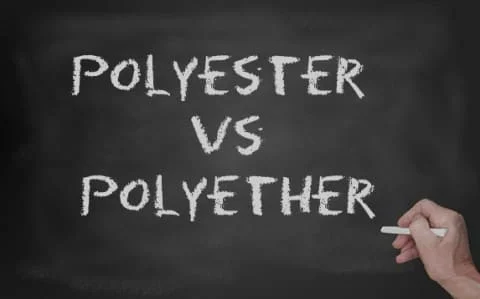There’s much to consider when buying flexible polyurethane foam. Density, tensile strength and Indentation Load Deflection are all important, but before looking at those there’s a more important property to consider: which type of foam will work best in the application?
There are two types to choose between: polyester polyurethane foam, and polyether polyurethane foam. Put side-by-side they’re virtually indistinguishable, yet the differences in their properties could have a big impact on how your foam-based product performs. This blog post explains the differences and addresses why one might work better than the other.
A Little Chemistry
A polyester is a compound made up from multiple esters, linked in various chains. An ester starts out as carboxylic acid, which consists of carbon, oxygen and hydrogen. Adding an “alcohol,” which in the chemical sense means a hydrocarbon compound like ethyl, replaces the hydrogen atom with a carbon-hydrogen compound. The result is a longer chain where the carbon and oxygen form a strong bond.
Ethers are only slightly different. Still a hydrocarbon, the oxygen forms two bonds to hydrocarbon compounds. One of the consequences is that ethers tend to be hydrolytically stable, or put more simply, don’t break down in the presence of water. This is one of the major differences between the two types of foam.
Properties of Polyether Foam
Foams made with ethers hold up well in wet conditions. They are generally soft and flexible, due in part to relatively large pores. They are also easier to make and so less expensive than polyester foam. That’s one reason polyether outsells polyester.
Polyester Foam Properties
Pound for pound, polyester foam is stronger than polyether and more rigid and supportive. Resistant to attack by many corrosive gases, it accepts additives providing fire-retardant properties and can also be formulated with electrostatic discharge (ESD) characteristics. (This type of foam is typically recognizable by its pink color.) Polyester polyurethane foam pieces can be welded together and it can be flame laminated, (where heat produces slight melting on one surface, letting it bond to another material.)
Two disadvantages against polyester are that it is:
- Hygroscopic, meaning it deteriorates in damp conditions.
- More expensive to produce than polyether.
Which to Use:
In general, polyether polyurethane foam is the material to use when cushioning is important, and especially if it might get wet. (Fabric-covered seats on a boat are a good example.) However, if the foam will be stretched or pulled, (as might happen when upholstering furniture,) or will be used for support and protection, (like in a transit case,) then polyester foam is the better choice. If the application is protection of electronic components then ESD protection should be considered, making polyester the only choice.
Consider the Application
Choosing polyurethane foam involves more than just looking at density; it’s important to select the right type of foam for the application. Polyether polyurethane foam is generally softer, less expensive, and doesn’t degrade when wet. However, if ESD protection or support are important, choose polyester polyurethane foam. Need more help? Give us a call and we can help you compare materials for your application.


